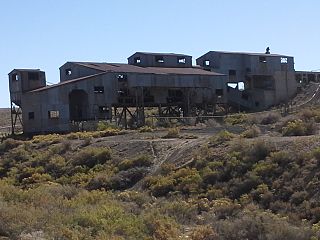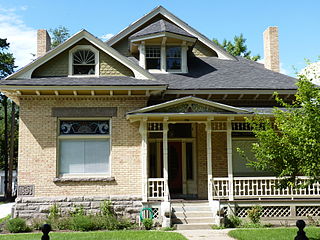
Roslyn is a city in Kittitas County, Washington, United States. The population was 893 at the 2010 census. Roslyn is located in the Cascade Mountains, about 80 miles east of Seattle.

The Virginian Railway was a Class I railroad located in Virginia and West Virginia in the United States. The VGN was created to transport high quality "smokeless" bituminous coal from southern West Virginia to port at Hampton Roads.

The Copper River and Northwestern Railway (CR&NW) consisted of two rail lines, the Copper River line and the Northwestern line. Michael James Heney had secured the right-of-way up the Copper River in 1904. He started building the railway from Cordova, Alaska in 1906. The town of Cordova, Alaska, was actually named by Heney on March 13, 1906, based on the original name given by Salvador Fidalgo. Both these railroads were abandoned and little remains of them. Only a 0-4-0 locomotive, "Ole", located near Goose City on a siding of the Alaska Anthracite Railroad Company is the only equipment left. Many of the holdings of the CR&NW railroad including Ole were acquired for this railroad by Mr. Clark Davis and his partners in 1908 after a major storm destroyed the Katalla area facilities in 1907. The town of Cordova would like to move Ole to a memorial site in Cordova to celebrate its role in these railroads. Ole was declared eligible for the National Register of Historic Places in 1988.

Glace Bay is a community in the eastern part of the Cape Breton Regional Municipality in Nova Scotia, Canada. It forms part of the general area referred to as Industrial Cape Breton.

The Quincy Mine is an extensive set of copper mines located near Hancock, Michigan. The mine was owned by the Quincy Mining Company and operated between 1846 and 1945, although some activities continued through the 1970s. The Quincy Mine was known as "Old Reliable," as the Quincy Mine Company paid a dividend to investors every year from 1868 through 1920. The Quincy Mining Company Historic District is a United States National Historic Landmark District; other Quincy Mine properties nearby, including the Quincy Mining Company Stamp Mills, the Quincy Dredge Number Two, and the Quincy Smelter are also historically significant.

The Reliance Tipple is the site of two coal tipples associated with coal production at Reliance, Wyoming. The first tipple was built in 1910 and used until 1936. The wood structure was built on a sandstone foundation and served Reliance Mines No. 1 through No. 6. The perishable portions of the earlier tipple have disappeared, leaving only the sandstone foundations and some artifacts buried in the tailings pile.

Kay Moor, also known as Kaymoor, is the site of an abandoned coal mine, coal processing plant and coal town near Fayetteville, West Virginia. The town site is located in the New River Gorge at Kaymoor Bottom (38°03′00″N81°03′17″W). It is linked to the mine portal 560 feet (170 m) above on Sewell Bench (38°02′52″N81°03′58″W) in the wall of the Gorge by conveyors.

The Berlin Historic District encompasses the ghost town of Berlin in Nye County, Nevada. The town was established in 1897 as part of the Union Mining District after the opening of the Berlin Mine the previous year. The name is a transfer from Berlin, in Germany, the native land of a share of the local prospectors. The town never prospered to the same extent as other boom towns like Tonopah and Goldfield, and declined following the Panic of 1907. The town was largely abandoned by 1911. The site was acquired by the state of Nevada as part of Berlin–Ichthyosaur State Park in 1970.

Robertsdale is an unincorporated community in Wood Township in southern Huntingdon County, Pennsylvania, United States. It is situated on Broad Top Mountain near the eastern slope. It was founded in 1872 as part of the construction of the East Broad Top Railroad and Coal Company as the original terminus and mining location. The town was created by the EBT's parent company, the Rockhill Iron and Coal Company, which operated most of the mines on the east side of the Broad Top Coal field. The initial focus of mining was the Houk Mine which predated the town, though as a much smaller producer. Later RI&C #5 became a large producer. Mines #2, #3 and #4 were in Robertsdale but were not large producers and operated only briefly. Later the EBT was extended to Woodvale, Alvan and new Alvan as the focus of mining moved along the coal seams, though Robertsdale remained the mining headquarters. Robertsdale was a typical coal ming town complete with company owned miner houses, a company store, a company owned water and power system and other company owned facilities. Coal mining and its support industries were the principal employers.

The Calumet Historic District is a National Historic Landmark District that encompasses most of the village of Calumet, Michigan. The district was designated in 1989 for the community's importance in the history of the region's copper mining industry.

The Dunlap coke ovens are the remnants of a coke production facility near Dunlap, in the U.S. state of Tennessee. Built in the early 1900s, the facility consists of five batteries of 268 beehive ovens, which operated under various companies until the early 1920s. The ovens are now listed on the National Register of Historic Places, and are maintained by the Sequatchie Valley Historical Society as part of Dunlap Coke Ovens Park.

The Smith–Dengler House is a private home located at 58555 US 41 in Wolverine, Calumet Charter Township, Michigan, United States. It was listed on the National Register of Historic Places in 2008.

The Charles E. Loose House is a historic house located in Provo, Utah, United States. The house was individually nominated for listing on the National Register of Historic Places in 1982 but was not listed due to owner objection. It later was included as a contributing property in the Provo East Central Historic District.

The John R. Twelves House is a historic house located in Provo, Utah, United States. It is listed on the National Register of Historic Places.

The Mariscal Mine, also known as the Lindsey Mine and the Ellis Mine, was a source of cinnabar ore that was refined at the Texas site into mercury. The mine is located in what is now Big Bend National Park. The mine produced a total of 1400 flasks of mercury, each weighing 76 pounds (34 kg), accounting for almost a quarter of the mercury production in the United States between 1900 and 1943.

The Smuggler-Union Hydroelectric Powerplant, also known as the Bridal Veil Powerhouse, is an electric power generation plant and residence located next to Bridal Veil Falls on a 400-foot (120 m) cliff overlooking Telluride, Colorado. The structure is 2-1/2 stories on a poured concrete foundation with a wood frame superstructure. It consists of a main power plant building, a 1-1/2 story residence and a 1-story cookhouse. The power plant foundation is distinctive, with semicircular windows. A semicircular bay with arched windows projects out on a rock spur.

The Merchants National Bank Building is a two-story, red brick building in Lehigh, Oklahoma, located at the southwest corner of Main Street and Railway Street. It was one of two banks that served Lehigh during the town's mining boom. It is listed on the National Register of Historic Places. It is historically significant because it represents the economic growth and decline of Lehigh and exemplifies Late Victorian Renaissance architecture.

The Buxton Historic Townsite is a historical site located east of Lovilia, Iowa, United States in rural Monroe County. The unincorporated community was founded in 1895, developed by the Chicago and Northwestern Railway as a coal mining company town to supply the railroad. It was a racially integrated community, in 1905 consisting of European immigrants and a majority-African American population, that was developed in the midst of southern Iowa coalfields.

Pacific Coast Company House No. 75, also known as Baima House, is a private residence in Newcastle, Washington. Built in 1880 or earlier, it was added to the National Register of Historic Places in 1979. The house is the only surviving structure associated with the early development of coal mining at Newcastle and is an example of the type of housing in which miners lived.




















